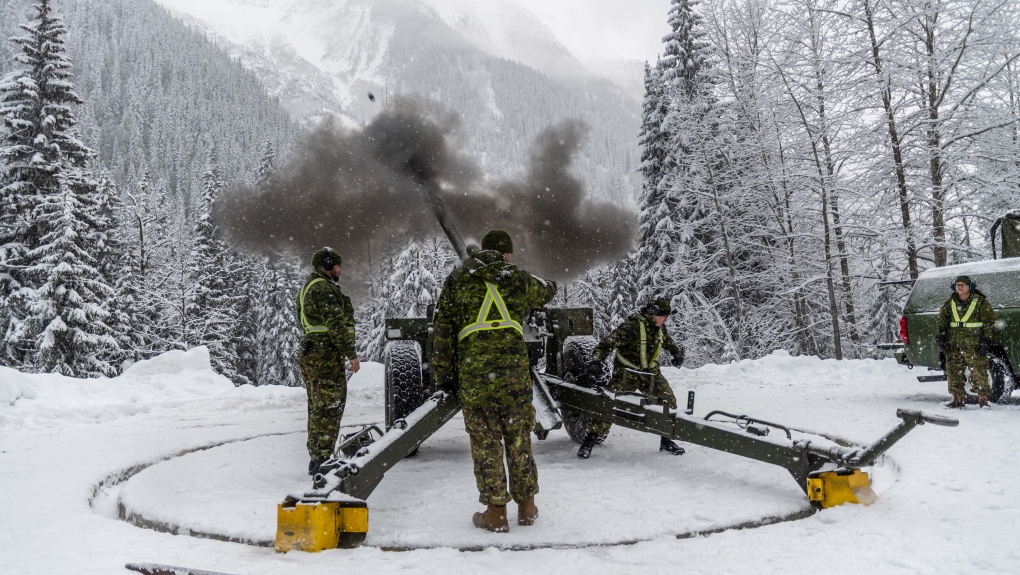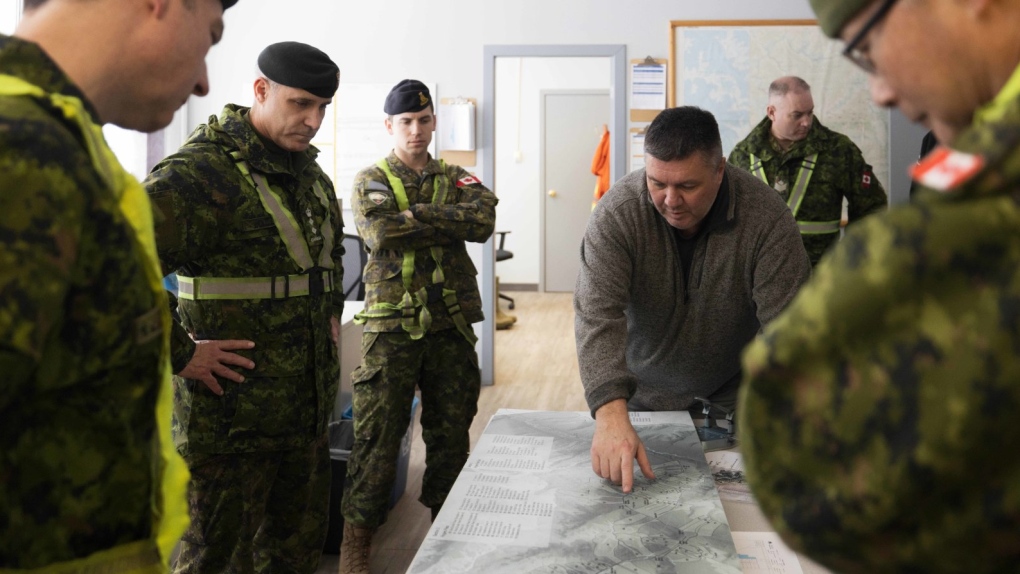Canadian artillery returns to the mountains of B.C. amid deadly 2023 avalanche season
 Artillery gunners from the Royal Canadian Horse Artillery fire a 105-mm Howitzer gun in Rogers Pass, B.C, during Operation Palaci. (M.X. Déry/Maritime Forces Pacific)
Artillery gunners from the Royal Canadian Horse Artillery fire a 105-mm Howitzer gun in Rogers Pass, B.C, during Operation Palaci. (M.X. Déry/Maritime Forces Pacific)
In the high mountain passes of southeastern British Columbia, the Canadian military is mounting another winter offensive in its six-decade war against ice and snow. This year's campaign comes at the close of an unusually deadly 2023 avalanche season in the western Canadian backcountry.
The latest troop of artillery gunners arrived in Glacier National Park in mid-November with three 105-mm Howitzer field guns trained on the narrow valley walls overlooking the Trans-Canada Highway and the Canadian Pacific Railway.
The soldiers will remain on the deployment into the new year when another rotation of troops will continue the work until the fight is abandoned in late March or early April.
Canada's longest-running military operation began in 1961, the year before the Trans-Canada Highway fully opened.
Every year since, dozens of soldiers and Parks Canada avalanche forecasters have trekked out to the area northeast of Revelstoke, B.C., to participate in Operation Palaci, the world's largest mobile avalanche-control program.
During a rotation change, there can be up to 50 Canadian Armed Forces members at the operation's main mountain compound, an apartment-style complex that provides food and lodging for the mission.
From there, the soldiers set out to staff the guns from 18 designated firing positions, primarily located in Rogers Pass, where the road and rail snake through the Selkirk Mountains in the most avalanche-prone travel corridor in North America.
At more than 1,300 metres above sea level, Rogers Pass averages about 14 metres of snowfall per year and contains more than 130 active avalanche paths crisscrossing the busy highway. In the winter months, the federal government estimates up to 4,000 vehicles and 40 trains travel through the pass daily.
It was here on March 4, 1910, that Canada's deadliest avalanche claimed the lives of 58 railway workers tasked with clearing the tracks after an earlier slide. It was here too, in 2003, that seven Grade 10 students from a private school south of Calgary died after they were buried under a massive avalanche. Seven other students and three teachers were swept up by the avalanche but survived.
 Commanders of the Canadian Brigade Group visit Operation PALACI, where the Canadian Armed Forces support Parks Canada in controlling avalanches in Rogers Pass, B.C., on Feb. 18, 2023. (Daniel Pereira/Canadian Armed Forces)
Commanders of the Canadian Brigade Group visit Operation PALACI, where the Canadian Armed Forces support Parks Canada in controlling avalanches in Rogers Pass, B.C., on Feb. 18, 2023. (Daniel Pereira/Canadian Armed Forces)
AVALANCHE CLOSURES COST $500K PER HOUR
Today, Parks Canada officials close a section of the highway while the gunners blast away at the unsteady snowpack before the shovels and ploughs come out to clear away the debris. With 270 pre-designated targets already dialed in, the Howitzers can fire effectively at night and in all weather conditions, hitting targets up to five kilometres away, Parks Canada says.
"Each shell is fired at a known trigger zone high up the slide path, creating a shockwave that releases an avalanche when snow conditions are right," the agency says.
In a slow season, they gunners will fire between 300 and 500 high-explosive shells into the mountainsides along the 40-kilometre corridor. During a busy year, the fire count rises to more than 1,000 rounds, according to Pedram Mohyeddin, a spokesperson for the Canadian Armed Forces.
Most highway closures for avalanche control last less than two hours, totalling around 100 hours of controlled closures annually, Parks Canada says.
"Highway closures in this area have an estimated $500,000-per-hour impact on Canada’s economy," Mohyeddin said. "The program continues to evolve to reduce highway closure times and improve safety for the travelling public, staff, and partners throughout the season."
Approximately 2,000 avalanches are recorded along the Trans-Canada corridor through Rogers Pass each year, with about 120 of those slides affecting the highway, Parks Canada estimates.
Sixteen people have been killed by avalanches in Canada in 2023, surpassing the national average of 11 avalanche deaths per year, according to Mary Clayton, a spokesperson with the Revelstoke-based Avalanche Canada.
Fourteen of those deaths were recorded in B.C., including five deaths in three separate slides near Glacier National Park.
CTVNews.ca Top Stories
Here's where Canadians are living abroad: report
A recent report sheds light on Canadians living abroad--estimated at around four million people in 2016—and the public policies that impact them.
What is a 'halal mortgage'? Does it make housing more accessible?
The 2024 federal budget announced on April 16 included plans to introduce “halal mortgages” as a way to increase access to home ownership.
'We are declaring our readiness': No decision made yet as Poland declares it's ready to host nuclear weapons
Polish President Andrzej Duda says while no decision has been made around whether Poland will host nuclear weapons as part of an expansion of the NATO alliance’s nuclear sharing program, his country is willing and prepared to do so.
Deadly six-vehicle crash on Highway 400 sparked by road rage incident
One person was killed in a six-vehicle crash on Highway 400 in Innisfil Friday evening.
Invasive and toxic hammerhead worms make themselves at home in Ontario
Ontario is now home to an invasive and toxic worm species that can grow up to three feet long and can be dangerous to small animals and pets.
Harvey Weinstein hospitalized after return to New York from upstate prison
Harvey Weinstein’s lawyer said Saturday that the onetime movie mogul has been hospitalized for a battery of tests after his return to New York City following an appeals court ruling nullifying his 2020 rape conviction.
Opinion I just don't get Taylor Swift
It's one thing to say you like Taylor Swift and her music, but don't blame CNN's AJ Willingham's when she says she just 'doesn't get' the global phenomenon.
Central Alberta queer groups react to request from Red Deer-South to reinstate Jennifer Johnson to UCP caucus
A number of LGBQT+2s groups in Central Alberta are pushing back against a request from the Red Deer South UCP constituency to reinstate MLA Jennifer Johnson into the UCP caucus.
Mookie Betts leads Dodgers past Blue Jays 4-2; Toronto drops fifth consecutive game
Mookie Betts went 3 for 5, including a triple and an RBI single, as the Los Angeles Dodgers beat the Toronto Blue Jays 4-2 on Saturday.

































